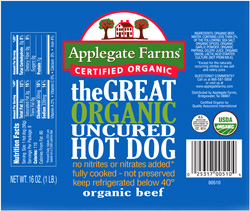
 Organic or regular: big difference! Photo by Sarah Lewis | SXC.
|
STEPHANIE ZONIS focuses on good foods and the people who produce them.
|
|
September 2006
Updated June 2009
|
 |

Organic Hot Dogs Vs. Conventional Hot Dogs
Page 4: The Benefits Of Organic Hot Dogs
Click here to read other Organic Matter columns
This is Page 4 of a six-page article. Click on the black links below to read other pages.
If you do believe that nitrates and nitrites adversely affect human health, does that mean you must eliminate hot dogs and other cured meats from your diet? Not necessarily. There’s a new breed of “dog” on the block, the organic hot dog. While it can’t solve every problem associated with hot dogs, it does eliminate some of the difficulties that have a lot of people concerned.
- To begin with, organic hot dogs must use organic meat. Unlike its conventional counterpart, organic meat is required to come from livestock raised without the use of growth hormones or antibiotics. The animals’ feed must also be grown and produced organically (no synthetic herbicides, pesticides, fungicides, insecticides etc.).
- The livestock raised for organic meat must be allowed access to fresh air and the outdoors; they must be given shelter reasonable for their species and their environment.
This system is not without flaws, and serious flaws, but at least it’s a step in what many feel is the right direction. There is a limited list of approved ingredients in organic processed foods, so nitrates and nitrites are not permitted in organic hot dogs.
Well, that should have gotten rid of the majority of objections, right? Not so fast! When organic hot dogs were first produced, about a decade ago, they were a food technologist’s nightmare. The lack of nitrates and nitrites was a very big problem. The early organic hot dogs had a brown hue, not the traditional pinkish color, and they didn’t have the beloved “cured meat” flavor; they also had a much drier texture. Consumers, especially the all-important under-eighteen set, turned up their noses in record numbers.
It’s only been more recently that food technology has caught up with the demands of  the market; These days, a “cure” of celery juice or celery seed extract, lactic acid starter culture, and/or sea salt, all of which are approved for organic foods, is the usual tonic of choice for organic hot dog manufacturers. This “cure,” applied even to those hot dogs labeled as “uncured,” prevents the growth of bacteria as effectively as nitrates/nitrites, and yields a hot dog much closer in color, flavor, and texture to the American classic. Interestingly, nitrates and nitrites have become unpopular enough so that this “cure” is now sometimes used in hot dogs that are not certified organic, as well. the market; These days, a “cure” of celery juice or celery seed extract, lactic acid starter culture, and/or sea salt, all of which are approved for organic foods, is the usual tonic of choice for organic hot dog manufacturers. This “cure,” applied even to those hot dogs labeled as “uncured,” prevents the growth of bacteria as effectively as nitrates/nitrites, and yields a hot dog much closer in color, flavor, and texture to the American classic. Interestingly, nitrates and nitrites have become unpopular enough so that this “cure” is now sometimes used in hot dogs that are not certified organic, as well.
Continue To Page 4: Organic Hot Dogs
Return To Article Index Above

|




 Organic or regular: big difference! Photo by Sarah Lewis | SXC.
Organic or regular: big difference! Photo by Sarah Lewis | SXC.  the market; These days, a “cure” of celery juice or celery seed extract, lactic acid starter culture, and/or sea salt, all of which are approved for organic foods, is the usual tonic of choice for organic hot dog manufacturers. This “cure,” applied even to those hot dogs labeled as “uncured,” prevents the growth of bacteria as effectively as nitrates/nitrites, and yields a hot dog much closer in color, flavor, and texture to the American classic. Interestingly, nitrates and nitrites have become unpopular enough so that this “cure” is now sometimes used in hot dogs that are not certified organic, as well.
the market; These days, a “cure” of celery juice or celery seed extract, lactic acid starter culture, and/or sea salt, all of which are approved for organic foods, is the usual tonic of choice for organic hot dog manufacturers. This “cure,” applied even to those hot dogs labeled as “uncured,” prevents the growth of bacteria as effectively as nitrates/nitrites, and yields a hot dog much closer in color, flavor, and texture to the American classic. Interestingly, nitrates and nitrites have become unpopular enough so that this “cure” is now sometimes used in hot dogs that are not certified organic, as well.